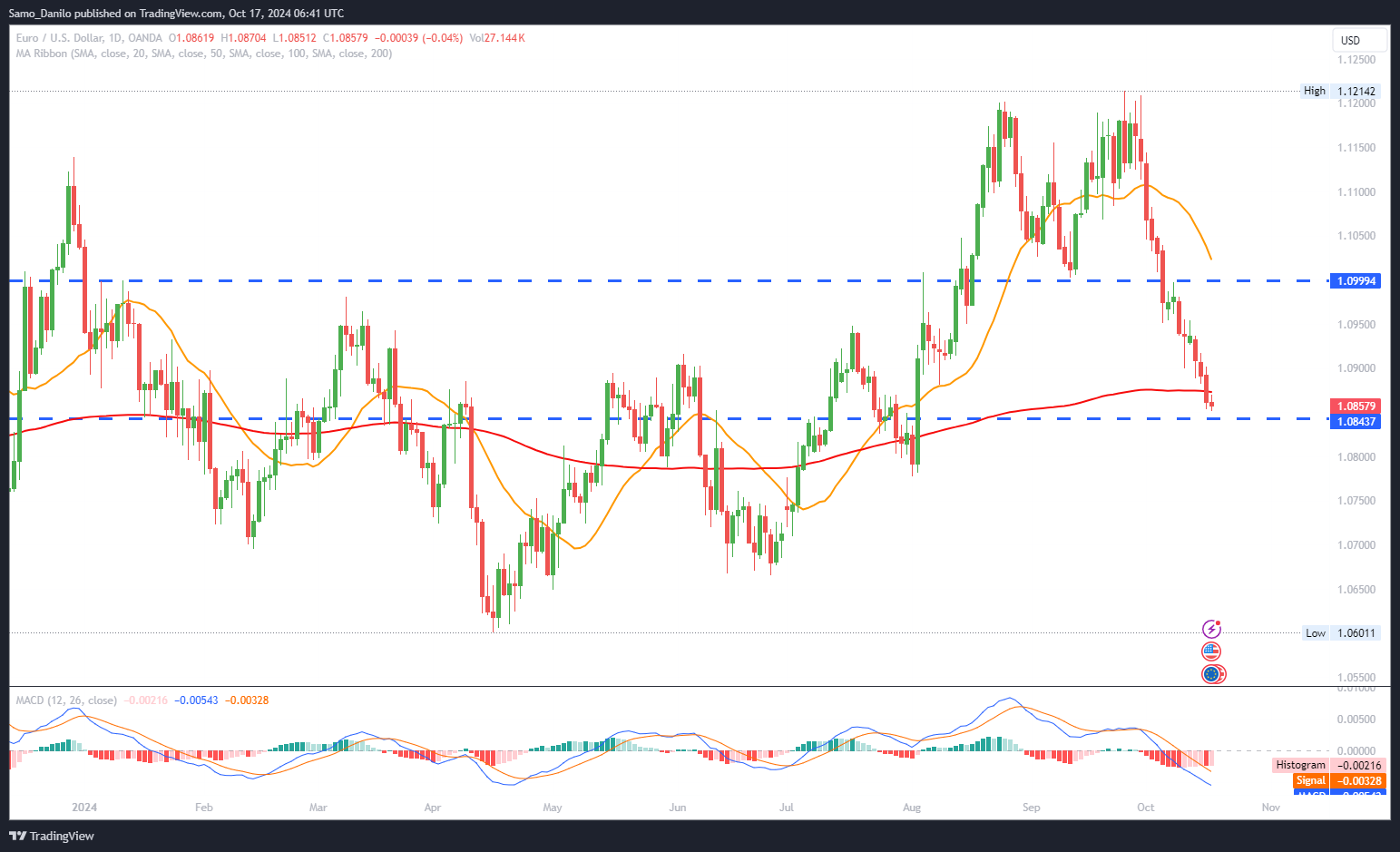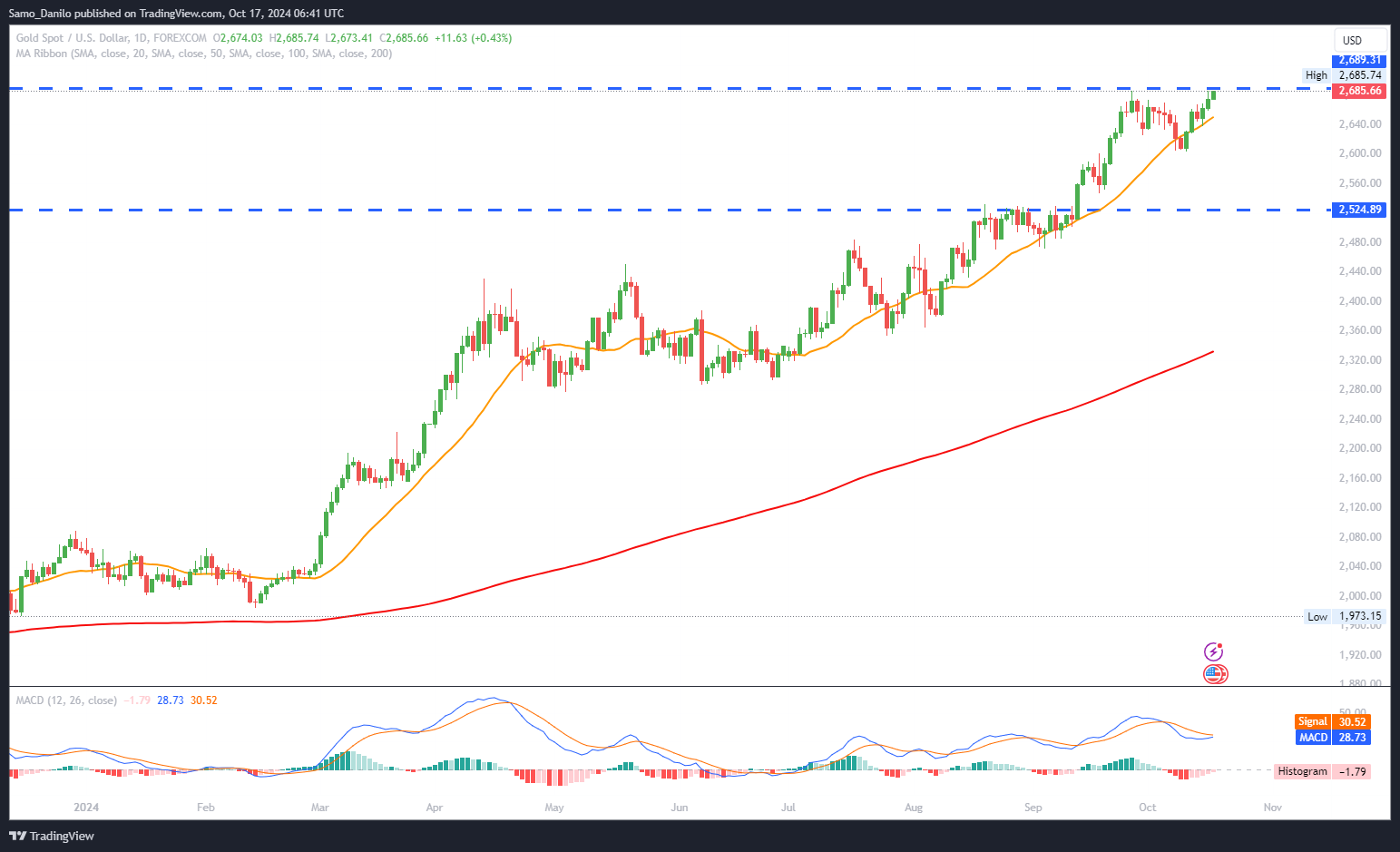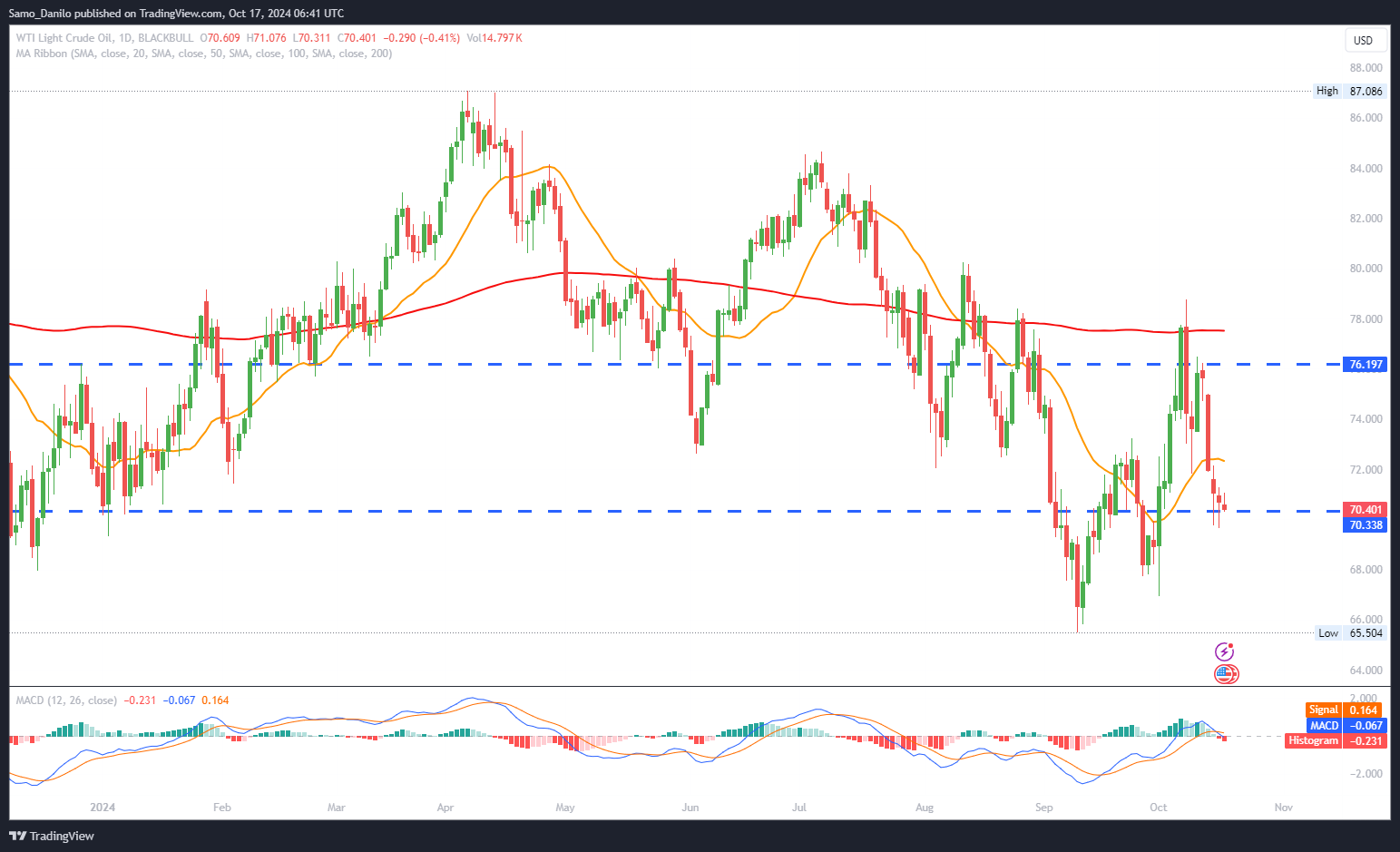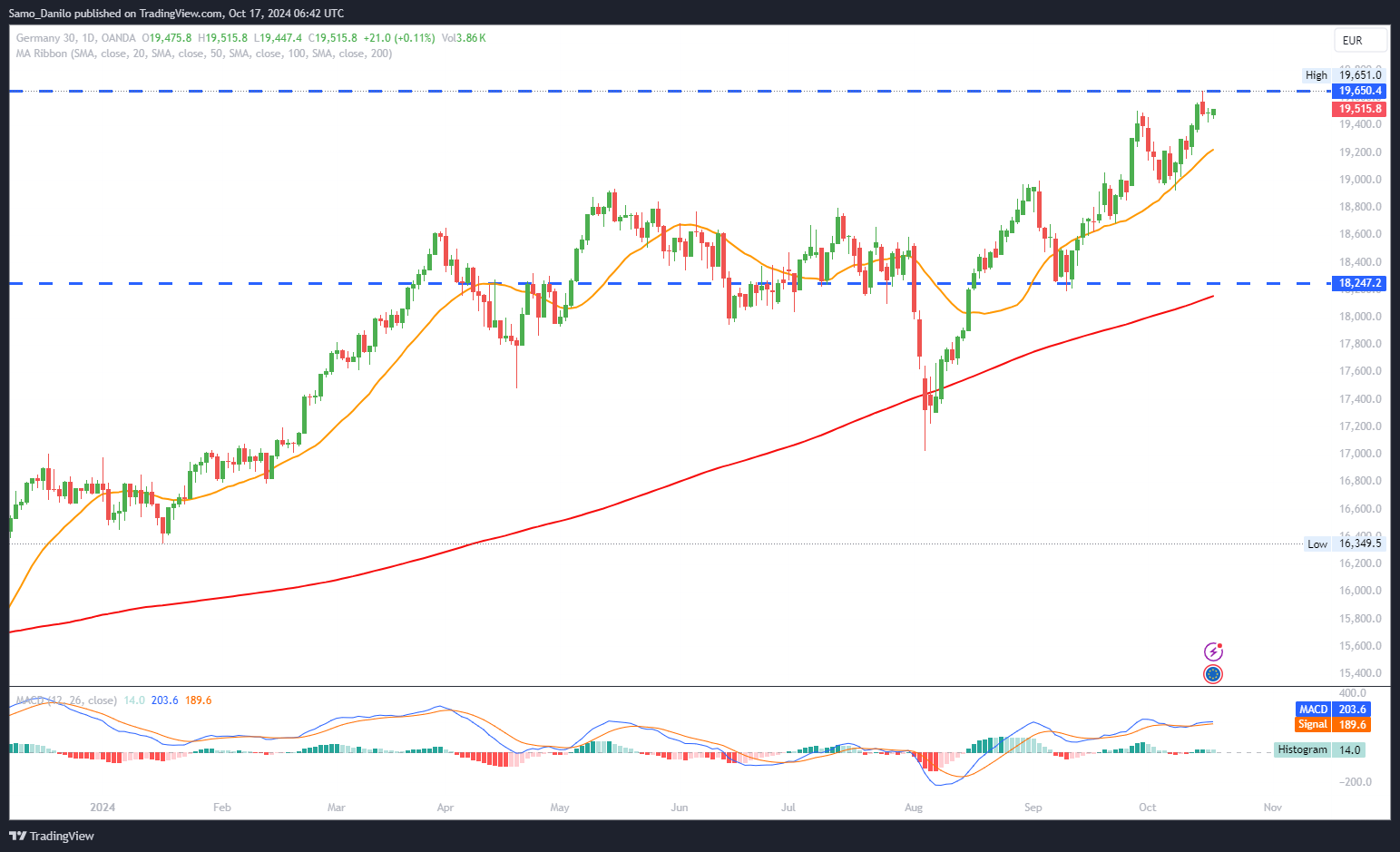EURUSD
- EUR/USD Price: The EUR/USD pair continues to decline, trading near 1.0850 during the early European session on Thursday. This marks a further drop, keeping the Euro under pressure against the strengthening US Dollar.
- ECB Meeting: Investors are closely watching the European Central Bank (ECB) monetary policy meeting on Thursday, with expectations of another interest rate cut. The outcome of this meeting will play a critical role in shaping market sentiment around the Euro.
- Lagarde's Comments: ECB President Christine Lagarde's post-meeting press conference will be pivotal. Traders will look for insights into the ECB’s policy direction for 2025, as well as Lagarde's view on inflation, growth prospects, and the broader economic outlook.
- Fed Commentary: Federal Reserve Governor Christopher Waller indicated earlier this week that future US interest rate cuts will be less aggressive compared to September's large reduction, due to concerns that the US economy could still be running at a hotter pace than anticipated. This keeps demand for the USD firm.
- US Retail Sales: Later Thursday, US Retail Sales data for September will offer further direction for the pair. Analysts expect retail sales to increase by 0.3%, up from the 0.1% growth recorded in August. A stronger-than-expected figure could provide additional support to the USD.
Closing statement: The EUR/USD pair remains under pressure as markets await the ECB's decision and Christine Lagarde’s remarks. With expectations of a rate cut and softer policy in Europe, combined with strong US data and cautious Fed commentary, the EUR/USD pair could see further downside unless the ECB surprises markets with a more hawkish tone.
GBPUSD
- GBP/USD Price: The GBP/USD pair consolidates its losses from Wednesday, following a drop to a two-month low due to softer UK Consumer Price Index (CPI) data. The British Pound remains under pressure, struggling to recover.
- Technical Setup: From a technical perspective, the pair broke below a one-week-old trading range and fell below the 1.3000 psychological level, reinforcing a bearish trend. This breakdown suggests a continuation of downward pressure on GBP/USD.
- UK Inflation Data: The UK's Office for National Statistics (ONS) reported that annual inflation, as measured by the Consumer Price Index (CPI), eased to 1.7% in September from 2.2% in August. The soft inflation data has raised expectations for a Bank of England (BoE) interest rate cut in November, which is weighing heavily on the Pound.
- BoE Rate Cut Expectations: The prospect of a BoE rate cut has been heightened by the weaker inflation figures. With lower inflation, the central bank may feel more comfortable easing policy to support the economy, further eroding the GBP’s strength.
- US Economic Data: On Thursday, US economic data, including the monthly Retail Sales report, Weekly Initial Jobless Claims, the Philly Fed Manufacturing Index, and Industrial Production data, will provide further direction for GBP/USD. Strong US data could bolster the US Dollar and push the pair lower.
| SMA (20) | Slightly Falling |
| |
| RSI (14) | Falling |
|
|
| MACD (12, 26, 9) | Falling |
|
|
Closing statement: The GBP/USD pair is in a bearish phase following the softer-than-expected UK inflation data, which fuels expectations of a BoE rate cut. Combined with a technical breakdown and strong US data on the horizon, the pair may face further downside unless there is a significant shift in sentiment or data surprises.
GOLD
- Gold Price: Gold continues to trade in positive territory for the third consecutive day on Thursday during Asian trading, consolidating near record-high levels. The precious metal has seen a steady rise in demand due to safe haven buying amid global uncertainties.
- China’s Property Market Measures Disappoint: China's latest support measures for its ailing property market failed to impress investors. The Chinese Housing Minister announced plans to increase credit for "white-list" projects to four trillion yuan by the end of the year, alongside promises to renovate one million homes. However, the market reaction has been muted, offering limited support to risk assets like gold.
- US Dollar: The US Dollar extended its rally on Wednesday, driven by increased expectations that Republican nominee Donald Trump may win the upcoming US presidential election on November 5. The Dollar’s strength has limited gold’s upside, as the two assets often have an inverse relationship.
- Fed Rate Cut Expectations: A 25 basis points (bps) rate cut by the US Federal Reserve (Fed) in November appears to be a foregone conclusion. This certainty has tempered the potential impact of upcoming US economic data, including Retail Sales figures, on market sentiment and gold price movements.
- US Macro Data: Risk sentiment remains a key driver for gold price action. The precious metal is likely to be influenced by US macroeconomic data releases, including Retail Sales, as well as Federal Reserve commentary (Fedspeak) in the lead-up to the November elections. Optimism surrounding Trump’s potential victory may also play a role in shaping the outlook for gold.
| SMA (20) | Rising |
|
|
| RSI (14) | Rising |
|
|
| MACD (12, 26, 9) | Slightly Rising |
|
Closing statement: Gold prices remain strong, consolidating near record highs amid global uncertainty and steady demand for safe-haven assets. However, the US Dollar’s recovery and the market's anticipation of a Fed rate cut in November could cap further upside for gold in the near term. The focus will remain on risk sentiment, US macroeconomic data, and political developments as the US election approaches.
CRUDE OIL
- WTI Price: West Texas Intermediate (WTI), the benchmark for US crude oil, is trading near the $70.00 mark on Thursday, reflecting a continued downward trend after a recent sell-off. This price level represents a decline in market sentiment as traders react to global developments.
- Geopolitical News: WTI prices have been pressured by reports indicating that Israel has assured the United States that its planned retaliatory strike on Iran will not target nuclear or oil facilities. This news eased fears of potential disruptions to oil supply, contributing to the softer crude prices.
- US Crude Oil Inventories: The American Petroleum Institute (API) reported that US crude oil stockpiles increased more than expected for the week ending October 11. The inventories fell by 1.58 million barrels, which was less than market expectations, adding to the bearish sentiment surrounding WTI prices.
- OPEC and IEA Forecast: Both the Organization of the Petroleum Exporting Countries (OPEC) and the International Energy Agency (IEA) revised their 2024 global oil demand growth forecasts downward earlier this week. The cut in demand projections weighs on crude oil prices, as the market anticipates a potential oversupply in the coming years.
- China's Economic Stimulus: Chinese officials are scheduled to hold a briefing later Thursday to discuss additional measures to support their economy. Given that China is the world’s largest consumer of crude oil, any fresh stimulus plans from Beijing could offer some support to WTI prices in the near term, potentially offsetting recent downward pressure.
| SMA (20) | Slightly Rising |
|
| RSI (14) | Slightly Falling |
|
| MACD (12, 26, 9) | Slightly Falling |
|
Closing statement: WTI crude oil prices remain under pressure, trading around $70 as global factors weigh on the market. Reports of Israel’s limited retaliation plans, rising US crude inventories, and downgraded oil demand forecasts from OPEC and the IEA are keeping crude prices subdued. However, potential economic stimulus measures from China could provide near-term support for oil prices, depending on the strength and scale of the proposed actions.
DAX
- Market Movers: Adidas saw a significant decline, with its stock tumbling by 6.26%, despite the company raising its full-year forecasts. The drop is attributed to broader market concerns and sector-wide impacts from weak demand, particularly from China.
- Weak Demand from China: The decline in the DAX’s Personal and Household Goods and Luxury Indexes was influenced by disappointing Q3 sales from LVMH. This performance highlighted weaker demand from China, which has weighed on stocks related to luxury goods and consumer spending.
- Eurozone Inflation: Investors are paying close attention to Eurozone inflation data, with figures showing the annual inflation rate easing to 1.8% in September, down from 2.2% in August. This comes as the European Central Bank (ECB) prepares to announce its interest rate decision, heightening market anticipation.
- Potential ECB Rate Cut: Expectations for a 25-basis point rate cut by the ECB on Thursday have fueled market speculation. If the ECB signals further support for a December rate cut, the DAX could push toward the 19,750 level. However, any hesitation or hints of delaying such a cut may see the DAX fall below 19,350, reflecting investor uncertainty.
- US Data: Later Thursday, US economic indicators such as retail sales and labor market data could further influence the market. Analysts expect retail sales to increase by 0.3% in September, up from a modest 0.1% rise in August. These figures may also shape market sentiment toward future Fed rate cuts, potentially impacting DAX-listed stocks.
| SMA (20) | Rising |
|
|
| RSI (14) | Rising |
|
|
| MACD (12, 26, 9) | Rising |
|
|
Closing statement: The DAX faces mixed signals as Adidas' stock decline, driven by weak demand from China, has weighed on the market, alongside disappointing luxury goods sales. Investors are keenly awaiting the ECB’s decision on interest rates, with a 25-basis point rate cut expected to push the index higher, while any uncertainty could see it slip. Additionally, upcoming US retail sales and labour market data could further shape market sentiment, influencing the DAX's trajectory through the week.




